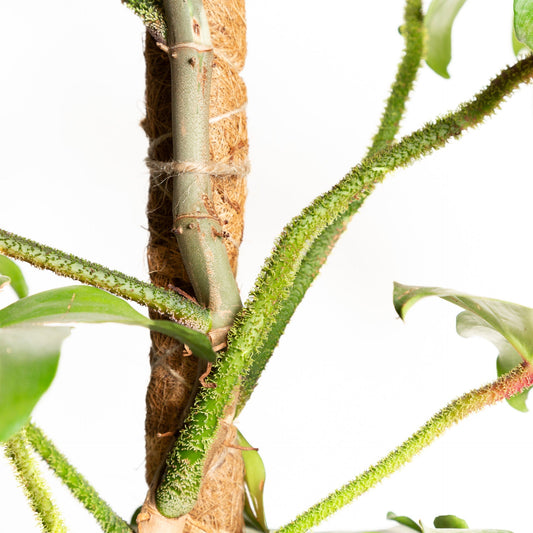Bedrooms are a critical space for our health. We spend a huge chunk of our day there sleeping, and sleep is one of the most important factors for our physical and mental health (alongside diet and exercise). What goes into our bedrooms matters a lot! So why are plants so important to put in there?
Because humans have generally evolved to exist in tandem with plants, we've developed a number of responses to their presence that start to come into play when it comes to sleeping near them. Most everything about plants, from their color to the sounds the make to the scents they give off, sends comforting signals to our brain that indicate to us that we're somewhere safe. These signals are very effective in helping people fall asleep and stay asleep.
AIR QUALITY
It's often the case that the air inside the bedroom is not given much thought beyond opening the window if it's too hot or turning on a fan, but the quality of our sleep is impacted by the quality of the air in the bedroom. If it's dusty or if there are a lot of contaminants, those enter our airways while we're sleeping and can cause minor reactions (which might result in things like coughing or sneezing), clog our sinuses, or worsen already present issues that negatively affect sleep quality. In particular, snoring is worsened by air that isn't clean and fresh.
Almost all of the foliage houseplants out there are effective air filters, so this is an excellent reason to include them in your bedroom. The more plants and the bigger the plants are, the better the air purification.
Despite most of the care tips floating around, the differences in the air purification abilities between plants are negligible when it comes to something like your home and not a controlled lab environment. It's very common for people to cite a particular NASA study conducted in 1989 that determined which plants were best at filtering certain contaminants from the air and found that snake plants were the best, but the truth is that all of the plants were fairly effective at filtering the air. So no need to worry about that!
When picking out plants for the purpose of air quality control, consider the planting medium that it's placed in and how wet or dry that material is going to be. You don't want to accidentally add dust to the air when you're trying to purify it! Generally speaking, soil that can dry out without poofing up dust and well-draining soil that is watered about once a week are reliably clean mediums (as long as you don't knock over the pot). Soil that is kept properly moist (such as in the case of ferns) will eliminate the risk of dust entirely.
COLOR
It's a lot more important than many people realize for bedroom plants to look absolutely amazing. The colors we fill our spaces with affect our mood in a big way, and we always want colors to reflect the purpose of a room.
In the case of bedrooms, we're usually looking for colors that are relaxing as opposed to energizing - while plants are obviously restricted to mostly greens, many have other prominent colors besides green that can be energizing (reds and yellows) or extra calming (browns, dark greens, silvers, occasionally blues). When you're picking out your bedroom plants, keep this in mind!
You'd be surprised how much of an effect color psychology can have on your sleep schedule. For example, ever wonder why all social media color schemes share a specific kind of blue, just tweaked to be lighter or darker? It's because looking at that blue makes it hard to fall asleep, so you stay on social media for longer instead of sleeping.
If your bedroom already has an established color scheme, don't get a plant that clashes too much with that. It's better to keep things cohesive than to have something stick out like a sore thumb, because that's just going to bother you to look at (which obviously overrides how calming the colors are).
CARE
The bedroom should not be a place that requires effort, so low-maintenance plants are highly recommended. In particular, snake plants make for excellent bedroom plants because they only want to be watered roughly once a month and are very forgiving of improper care. They also come in a variety of colors for you to choose from!
It's not crucial that you find a plant with little to no care requirements, especially if you're an established plant owner. Just make sure you get a plant that you enjoy taking care of and that you think looks gorgeous so that you're not adding any stress to your sleep environment.
OUR BEDROOM PLANT SUGGESTIONS
- Snake plants - snake plants are low maintenance, forgiving, durable, and clean plants that do their air purifying at night. They also rarely experience pests or fungi because of how little water they need. You can literally put a snake plant anywhere and it will be fine as long as you don't give it water until it looks sad. Besides being a convenient trait, this is also excellent for boosting your confidence as a plant parent!
- Cast iron plants - so named because of their durability, cast iron plants are beautiful and lush plants with very little fuss.
- ZZ plants - frequently smaller than snake plants and cast iron plants, zz plants are great for placing on bedside tables or bookshelves and are still very low fuss plants.
- Pothos - pothos is famous for being very easy to grow and loves to vine all over the place, which ups its abilities as an air purifier because more leaves equals more surface area to purify the air with. If it doesn't receive enough sunlight, that doesn't mean it will die - it will simply grow smaller leaves or stop lengthening its vines. If it receives plenty of filtered sunlight, then it will grow large and majestic leaves.
- Marimo - while lacking the ability to purify the air, marimo are absolutely adorable and practically maintenance free (you just have to change their water occasionally). They love to slowly roam whatever enclosure you've placed them in and it feels like putting a friend in your room, just without the hassle of fish or small animals. Watching them bob around is incredibly relaxing.
- Ferns - ferns want their soil to be kept consistently moist (not sopping wet, though!) and most want to be misted at least once every day or two. While for some that can seem an unwelcome hassle, many find a daily misting to be a meditative and very easy note to incorporate into their day - especially if you keep an attractive looking mister next to it. Ferns move water through their system very quickly, and if you have a room with dry air then a fern will help to humidify your space and help your throat feel less dry in the mornings. Many ferns can also grow to be larger than either the cast iron or snake plants, and if you're looking for a particularly lush look, then this is a great option!




Comments (2)
oxTCbSuaHzwMK
gLhZtDlNTiycMbI